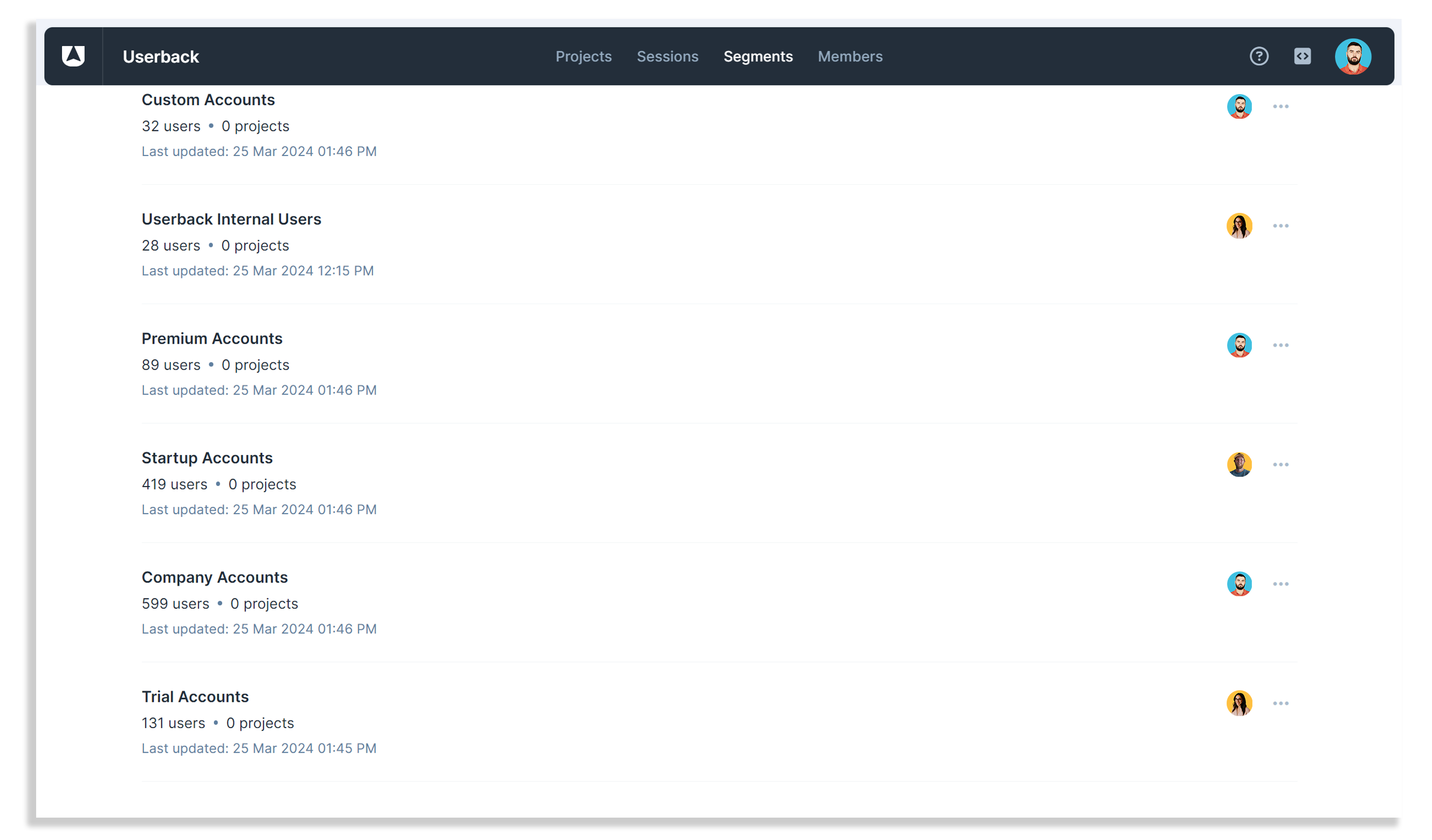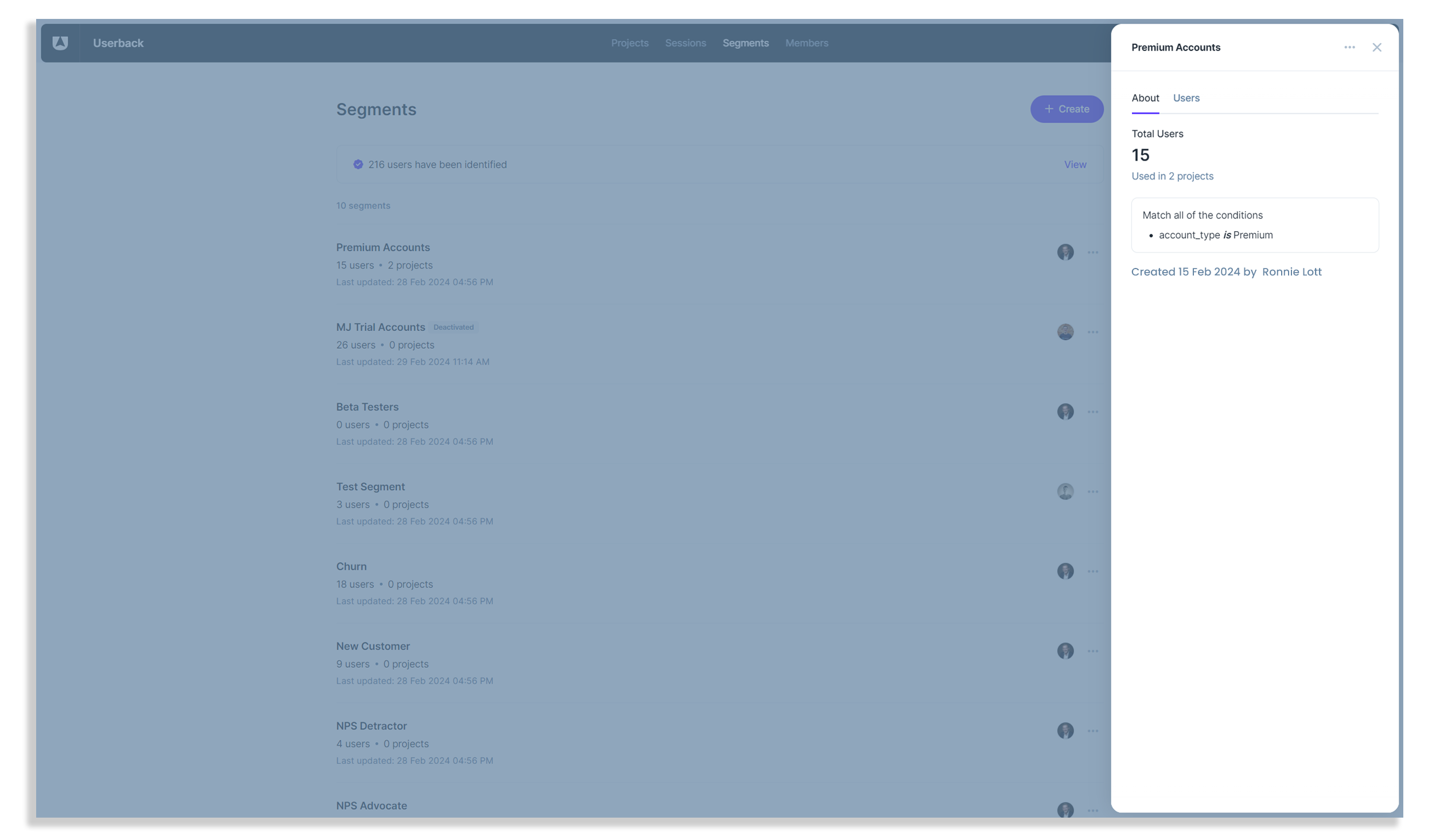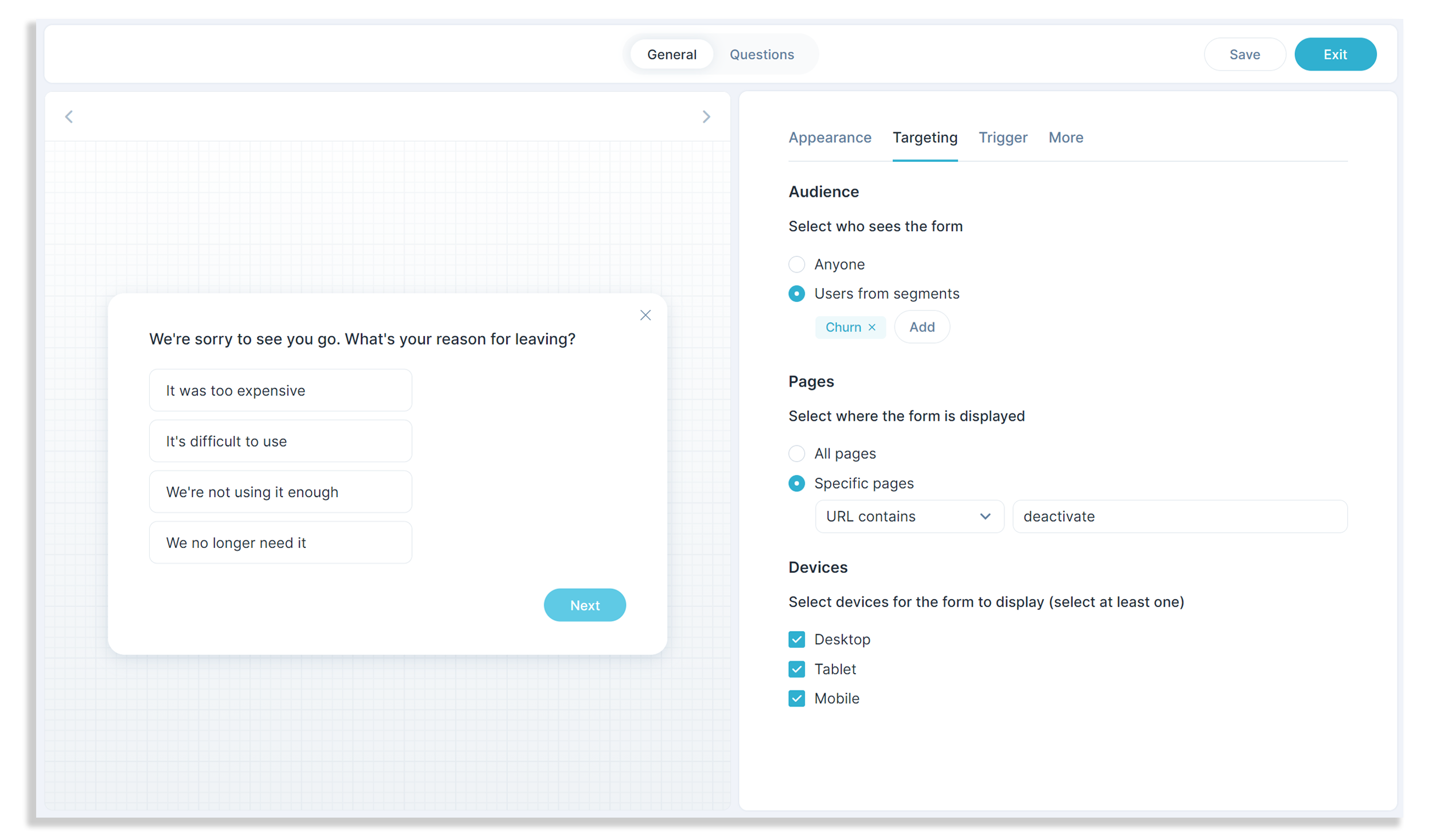
Leveraging User Segments for Enhanced SaaS Retention
So, why care about user segments? In the crowded and competitive SaaS industry, retention is a key success metric owing to its impact on long-term revenue and growth potential. However, businesses often face challenges in this area due to high customer churn rates, which can result from factors like inadequate customer engagement, undifferentiated service offerings, and a failure to deliver continuous value. Moreover, a lack of personalized experiences and failure to address the specific needs of different user segments can exacerbate the issue, leading to reduced customer satisfaction and loyalty.
Understanding user segments is crucial as it allows SaaS companies to tailor their product features, support services, and marketing messages to meet the unique needs and preferences of each segment. By analyzing usage patterns, business size, and industry needs, businesses can identify distinct clusters within their user base and customize their approach to address specific pain points. This personalized engagement increases perceived value, fosters deeper product adoption, and strengthens user commitment, thereby driving down churn and bolstering retention rates.
Identifying Key User Segments
User segmentation can be approached through various methodologies, each providing unique insights that can inform a SaaS company’s retention strategies.
- Behavioral segmentation looks at user engagement levels, feature usage frequency, and in-app behavior patterns to delineate active from less engaged users.
- Demographic segmentation, on the other hand, categorizes users based on firmographics such as company size, industry, or geographic location, identifying how different characteristics influence the need for particular SaaS features.
- Psychographic segmentation goes deeper, examining the motivations, goals, and pain points of users, thereby uncovering the psychological or emotional aspects driving product usage. By leveraging these segmentation strategies, SaaS businesses can gain a multidimensional understanding of their user base, which is critical for crafting tailored, impactful retention tactics.
The availability of data analytics tools has simplified the process for SaaS businesses to collect and analyze extensive user data. This empowers them to gain profound insights into their user segments. By monitoring important metrics such as product usage patterns, churn rates, and feature adoption rates, companies can identify trends and behaviors that guide their segmentation strategies. Additionally, the implementation of predictive analytics can aid in recognizing potential churn risks, enabling companies to personalize retention efforts for at-risk users.

Understanding Segment-Specific Needs and Preferences
Once key user segments have been identified, the next step is to develop detailed profiles for each segment. These profiles should include demographic, behavioral, and psychographic data points. For example, a SaaS company targeting small businesses might create profiles for micro-businesses (1-10 employees), small businesses (11-50 employees), and medium-sized enterprises (51-250 employees). These profiles could also include information on the industries or verticals that each segment operates in, feature usage patterns, desired outcomes from using the software, and any challenges or pain points faced by each segment.
By doing so, SaaS companies can gain a deeper understanding of their users’ varied needs and preferences. This intelligence can inform product development efforts to ensure that they address specific pain points and cater to the unique needs of each segment.
Catering to different user needs and preferences
Determining the unique needs and preferences of users within different segments requires a targeted and systemic approach. SaaS product teams can leverage direct and indirect feedback mechanisms such as surveys, interviews, and focus groups to gather qualitative insights directly from users. It’s important that these inquiries are tailored to uncover the specific utility and performance expectations different segments have from the product.
In addition to user feedback, product teams can analyze in-app behavior data to discern which features are most used and valued by each segment. A/B testing of new features or user interface changes can provide quantitative data on preferences and engagement for further fine-tuning. Furthermore, ongoing analysis of support ticket themes and frequency can reveal areas where different segments encounter difficulties or lack desired functionalities.
By synthesizing the qualitative with the quantitative—customer feedback with actual usage data—SaaS companies can build a comprehensive profile of segment-specific needs and preferences. This approach not only informs product development but can also guide customer success initiatives to ensure that service delivery aligns with the unique expectations of each identified user segment.
Personalizing User Experiences
Customizing user interfaces and features
Customizing user interfaces and features is a pivotal strategy for enhancing user satisfaction and retention within different segments. By offering a flexible UI that adapts to the user’s role, industry, or preference, SaaS companies can provide a more intuitive and streamlined user experience. For instance, dashboards can be tailored to surface data and analytics most relevant to a segment’s objectives, or workflows can be simplified based on the common tasks of users in that segment. Feature customization can also involve enabling or disabling certain functionalities to meet the sophistication and needs of different user groups. This level of personalization results in a more relevant product offering for each user, which can significantly reduce churn by promoting higher engagement and long-term commitment to the product. Personalization reflects an understanding of, and a response to, segment-specific usage patterns and the varying goals of different types of users, ultimately leading to a more cohesive and satisfying user experience.
Tailoring communication and support
Tailoring communication and support according to different user segments is another cornerstone for ensuring user satisfaction and retention. By using the insights gained from user segmentation, SaaS companies can provide segment-specific support resources and communication strategies. For example, technical support and customer service can be adapted to address the common questions and challenges faced by each segment. Incorporating customer relationship management (CRM) systems that log customer interactions allows for personalized follow-ups and communication based on the user’s history and preferences. Training materials and help documents can also be customized to the technological proficiency and business needs of each segment. This approach ensures that each user feels understood and valued, further cementing their loyalty to the service. Above all, it fosters a sense of trust and partnership between the user and the SaaS provider, with communications and support acknowledging the distinct needs of different user segments.

Creating Targeted Retention Strategies
Segment-specific engagement tactics, personalized promotions and offers, and targeted onboarding and training programs are all essential components of a robust retention strategy. Each segment has unique motivations for using the product, expectations for its performance, and preferred methods of communication. As such, retention initiatives should be tailored to meet the specific needs and preferences of each segment.
For example, small business owners may appreciate targeted promotions or discounts on upgrades that can help them manage their finances more efficiently. On the other hand, medium-sized enterprises might prioritize support resources such as training programs or dedicated account managers to assist with complex integrations or customizations. By understanding these distinct priorities, SaaS companies can develop retention initiatives that resonate with each segment and foster long-term loyalty to the product.
Personalized promotions and offers
Personalized promotions and offers can also play a significant role in retaining users within specific segments. By leveraging data on usage patterns, feature adoption rates, and renewal cycles, SaaS companies can tailor promotional offers to different user groups. For example, offering discounted upgrades or add-ons based on the features most valued by each segment can incentivize continued use of the product.
Targeted onboarding and training programs
Targeted onboarding and training programs can also have a significant impact on user retention within different segments. By understanding the varying levels of technical proficiency and specific needs of each segment, SaaS companies can develop personalized training resources that help users fully utilize the product’s capabilities. This not only improves satisfaction with the product but also fosters a deeper understanding of its value and can lead to increased retention.
By leveraging user feedback, behavior data, and targeted retention strategies, SaaS companies can provide a more intuitive and tailored experience for each segment, ultimately leading to higher engagement and long-term loyalty to the product. So, it is crucial for SaaS companies to constantly gather and analyze data on user segments, and use that information to inform product development, communication, and retention strategies. Through personalization, SaaS companies can build strong relationships with their users, promote customer satisfaction and loyalty, and ultimately drive business success. So, by understanding the unique needs of each segment and catering to those needs
Retention metrics and goals for each user segment
Retention metrics and goals should also be tailored to each of your user segments. By setting specific targets for each user group, SaaS companies can better assess the effectiveness of their retention strategies and make data-driven decisions for improvement.
For example, a small business segment may have higher churn rates due to budget constraints or limited resources. In this case, the goal might be to maintain a certain percentage of renewals within that segment or reduce churn by a specific percentage. On the other hand, a larger enterprise segment may have higher expectations for product performance and customer service. In this case, the goal might be to increase overall satisfaction scores or ensure a certain level of response time for support inquiries.
By setting targeted goals and tracking retention metrics within each segment, SaaS companies can identify areas for improvement and adjust their strategies accordingly to keep each segment satisfied and engaged with the product.
Five of the most common metrics and goals used by SaaS product teams include those listed below, each needs to be considered for your particular user segments and your business requirements.
- Customer Churn Rate: Reflects the percentage of customers who cancel or do not renew their subscriptions within a certain time period. It is crucial for identifying trends in customer loss and implementing strategies to improve retention.
- Customer Lifetime Value (CLTV): Measures the total revenue a business can reasonably expect from a single customer account throughout the business relationship. It helps in understanding the long-term value of customers and informs decisions on how much to invest in retaining them.
- Net Promoter Score (NPS): Gauges customer satisfaction and loyalty by asking how likely customers are to recommend the product to others. A high NPS is often correlated with high customer retention rates.
- Monthly Recurring Revenue (MRR) Retention Rate: Tracks the amount of recurring revenue retained from existing customers each month, taking into account upgrades, downgrades, and churn. It is a dynamic indicator of the company’s performance in retaining current subscriber revenue.
- Customer Engagement Score: A composite metric that considers a variety of user actions to assess the level of engagement with the product. This can include frequency of use, feature utilization, and interaction with support and training resources. An engaged customer is more likely to be a retained customer.

Using Feedback to Refine Segmentation
Implementing user feedback loops is a crucial aspect of refining segmentation and retention strategies. By regularly soliciting feedback from different segments, companies can gain valuable insights into the needs, pain points, and preferences of each group.
This feedback loop can seem daunting to time poor product managers and product teams, however with a pragmatic approach (and the right tools), any team can plan and execute on these five key steps to implement a robust user feedback loop to refine user segments.
- Continuous Collection of User Feedback: To refine user segmentation effectively, SaaS companies should implement a structured approach to continuously collect feedback from users. This can involve the use of surveys, in-app feedback prompts, and customer interviews that seek to understand the user’s experiences, challenges, and preferences.
- Integration of Feedback Tools: Integrating feedback tools such as Net Promoter Score (NPS) surveys, customer satisfaction (CSAT) survey, and customer effort score (CES) assessments directly into the product can offer real-time insights into user sentiment and satisfaction levels.
- Data Analysis and Segmentation Refinement: Analyzing the collected feedback data is crucial for uncovering patterns and themes that can inform refinements in segmentation. For instance, if a number of users from a particular segment consistently request specific features or report similar issues, this information can be used to create a more homogenous and accurate segment.
- Feedback-Informed Product Development: The insights gained from user feedback should be leveraged to inform product development decisions. Features and improvements that align with the needs of specific segments can be prioritized, which will likely increase user satisfaction and retention in those segments.
- Closing the Feedback Loop: It is essential to close the feedback loop by communicating back to users how their input has led to tangible changes in the product or service. This not only validates the user’s effort in providing feedback but also demonstrates that the SaaS company is committed to evolving the product to meet its users’ needs.
By consistently applying these steps to implement and refine user feedback loops, SaaS companies can enhance their user segmentation approach and create more personalized experiences that drive user satisfaction and retention.
Continuous improvement of user segments
Continuous improvement of segmentation accuracy and effectiveness is key to long-term retention success. Regularly reassessing the needs, behaviors, and preferences of user segments through data analysis and feedback collection can help SaaS companies stay ahead of changing market trends and evolving customer needs. By setting specific targets for each segment and regularly tracking metrics related to retention, SaaS companies can make informed decisions that drive customer satisfaction and ultimately, business growth. With a strong understanding of user segmentation and effective utilization of feedback, SaaS companies can create a competitive advantage in the market and build a loyal customer base that continues to support their product for years to come.
So while identifying and understanding key user segments is crucial for any SaaS company, it is also important to continuously refine these segments through data analysis and feedback. By doing so, companies can stay attuned to their customers’ needs and deliver a product that truly meets their expectations, leading to higher retention rates and ultimately, business success. So don’t just stop at creating initial segments, make sure to continuously improve and refine them for long-term retention success.
Areas you can embrace to help with improving your user segments and their interaction within your growing SaaS products include:
- Embrace Machine Learning: Utilize machine learning algorithms to analyze large datasets efficiently, uncovering hidden patterns and behaviors that can lead to more granular and predictive user segmentation.
- Segment by Customer Journey Stage: Identify and segment users based on where they are in the customer journey (e.g., new sign-ups, active users, at-risk of churning), and tailor marketing and support initiatives accordingly.
- Leverage Qualitative Data: Incorporate qualitative data from user interviews, open-ended survey responses, and customer support interactions to add depth to your quantitative segment analyses.
- Optimize Segments for Personalized Marketing: Use your refined segments to create personalized marketing campaigns that resonate with the specific goals, pain points, and interests of each subset of your user base.
- Monitor Segment Evolution Over Time: Segments are not static; monitor how they change over time and adjust your segmentation model accordingly to ensure continued relevance and accuracy.
Key takeaways regarding user segments
Summarizing the impact of segmentation on SaaS retention: Segmentation is crucial for SaaS companies to understand their users and deliver personalized experiences that drive satisfaction and retention. By continuously improving and refining segments through data analysis and feedback, companies can stay attuned to evolving customer needs and build a loyal user base.
Embracing a data-driven approach: To effectively refine user segments, it is important for SaaS companies to embrace a data-driven approach. This can involve implementing tools and strategies for collecting, analyzing, and utilizing user feedback to inform product development decisions.
Importance of ongoing segmentation maintenance: Segmentation is not a one-time exercise; it requires constant monitoring and adjustment to remain relevant and effective. By regularly reassessing segments and making necessary refinements, SaaS companies can stay ahead of market trends and ensure long-term retention success. So remember, don’t just set it and forget it when it comes to user segments; ongoing maintenance is key.
Userback is here to help
In conclusion, segmentation plays a critical role in SaaS companies’ efforts to retain customers and drive business growth. By continuously improving and refining segments through data analysis and feedback, companies can create personalized experiences that meet their users’ evolving needs, leading to higher satisfaction and retention rates. By utilizing Userback’s user feedback platform, you can easily start segmenting your customers and moving forward in planning the right strategies that best fit each segment.
So make sure to prioritize segmentation in your company’s strategy and consistently work towards improving and refining it for long-term success. Now go forth and segment like a pro! 🚀
